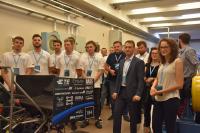Students’ electric bolide

The PD1 bolide’s first public appearance at the Faculty of Automotive and Construction Machinery Engineering of the Warsaw University of Technology, photo: Office for Promotion and Information
Sleepless nights, constant brainstorming sessions and hectoliters of coffee – this is how the Proton Dynamic team members summed up the two-year process which led them to achieve their desired goal, that is the creation of the Student Formula electric bolide.
It was on Friday, July 19, when we had a chance to admire the results of the work carried out by the students of both the Warsaw University of Technology and of the SGH Warsaw School of Economics.
During this official event, held in the building of the Faculty of Automotive and Construction Machinery Engineering of the Warsaw University of Technology, the Proton Dynamic team presented the PD1 bolide to all the guests.
Those who are real Formula 1 fans may be astonished by some attributes of the students’ bolide. The feature that distinguishes the PD1 from other F1 vehicles weighing over 600 kg is its lightness, with curb weight of 240 kg. The electric motor ensures the peak power of 80 kW, while the lithium-ion high current cells are responsible for the energy supply. The vehicle reaches 0-100 kph in under 4 seconds and attains the maximum speed of 105 kph. Interestingly, the bolide’s steering wheel was 3D-printed. It was the students themselves – with the support of numerous investors – who designed and manufactured most of the sub-assemblies.
The authors emphasize that the bolide’s two main components, i.e. the energy storage system and the electronics, were designed not only for the purpose of the vehicle’s acceleration. Above all, they must guarantee the safety of the vehicle’s user. Failure to do so results in the bolide’s disqualification from the races.
See the photos from the PD1 bolide’s presentation
The PD1 appeared for the first time in public shortly before this year’s Formula Student Italy 2019 competition, in which the vehicle will make its debut. In 2018 our students also took part in this competition series, but at that time their vehicle did not enter the competition. Their attendance at that event, talks with the judges and conclusions drawn from observations opened up an opportunity, and Proton Dynamic seized it to improve its own design, modify the assumptions, and consequently focus on developing the whole project.
We would like to congratulate the authors of the PD1 on their great accomplishment and we wish them success both in the races all around the world, especially in the Formula SAE Italy that starts today.







